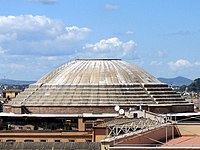
Photo from wikipedia
The mixing proportions of concrete were examined with regard to the durability performance and early strength in coastal areas. Research was conducted to improve the C24 mix (characteristic strength of… Click to show full abstract
The mixing proportions of concrete were examined with regard to the durability performance and early strength in coastal areas. Research was conducted to improve the C24 mix (characteristic strength of 24 MPa). C35 concrete (characteristic strength of 35 MPa) was selected as a comparison group, as it exhibits the minimum proposed strength criterion for concrete in the marine environment. To secure the early strength of the C24 concrete, 50% of the total ordinary Portland cement (OPC) binder was replaced with early Portland cement (EPC); and to provide durability, 20% was substituted with ground granulated blast-furnace slag (GGBS). In addition, a polycarboxylate (PC)-based superplasticizer was used to reduce the unit water content. The compressive strength, chloride ion diffusion coefficient, chloride penetration depth, and pore structure were evaluated. After one day, the compressive strength improved by 40% when using EPC and GGBS, and an average increase of 20% was observed over 91 days. EPC and GGBS also reduced the overall porosity, which may increase the watertightness of concrete. The salt resistance performance was improved because the rapid early development of strength increased the watertightness of the surface and immobilization of chloride ions, decreasing the chloride diffusion coefficient by 50%.
Journal Title: Applied Sciences
Year Published: 2020
Link to full text (if available)
Share on Social Media: Sign Up to like & get
recommendations!